Understanding Your Nursery’s Cooling Needs
Creating a comfortable and safe environment in your baby’s nursery is essential for their well-being. One critical aspect of this is managing the room’s cooling system effectively. This guide breaks down the key considerations for maintaining optimal temperature, proper humidity levels, and ensuring low noise levels to make your nursery the perfect haven for your child.
Maintaining Optimal Temperature
Babies cannot regulate their body temperature as efficiently as adults, making it crucial to maintain a consistent and safe room temperature. Experts recommend keeping the nursery temperature between 68°F and 72°F (20°C to 22°C) for optimal comfort.
- Use a thermostat to monitor and control the room temperature precisely.
- Consider air conditioners with smart temperature controls, which can adjust cooling levels automatically based on the room’s heat.
- Avoid placing the crib directly in the path of cool air, as it may create a draft.
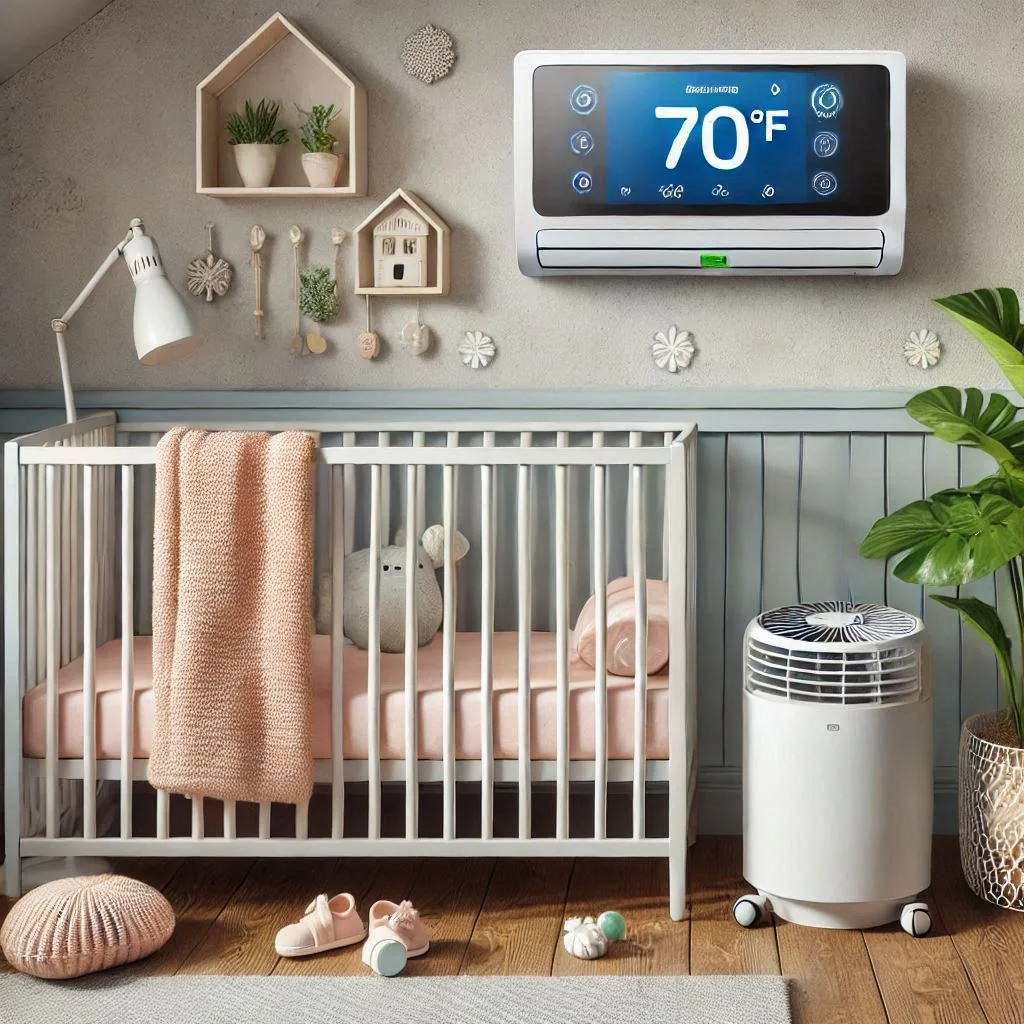
Ensuring Proper Humidity Levels
Humidity control is as important as temperature in maintaining a healthy environment. High humidity can encourage mold and dust mites, while low humidity may dry out your baby’s sensitive skin and nasal passages.
- Maintain humidity levels between 40% and 60%.
- Choose an air conditioner with built-in dehumidification features or pair it with a humidifier for added balance.
- Regularly check for condensation near windows or walls to prevent mold growth.
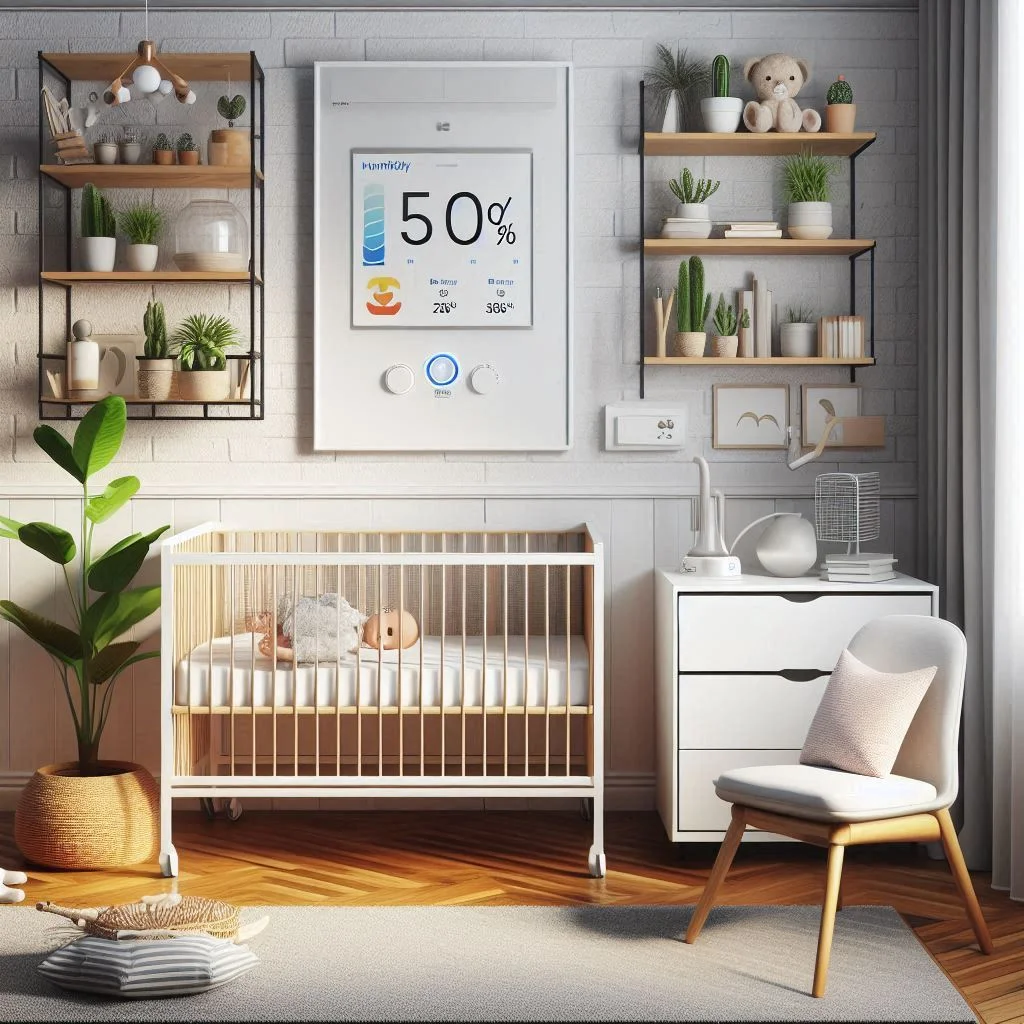
Noise Levels for Baby’s Comfort
Babies are highly sensitive to noise, and the humming or buzzing of an air conditioner can disrupt their sleep. It’s crucial to invest in a unit that operates quietly.
- Look for air conditioners with a noise rating below 50 decibels (dB).
- Opt for models with “quiet mode” or “sleep mode” settings to minimize operational sound.
- Position the unit away from the crib to further reduce noise impact.
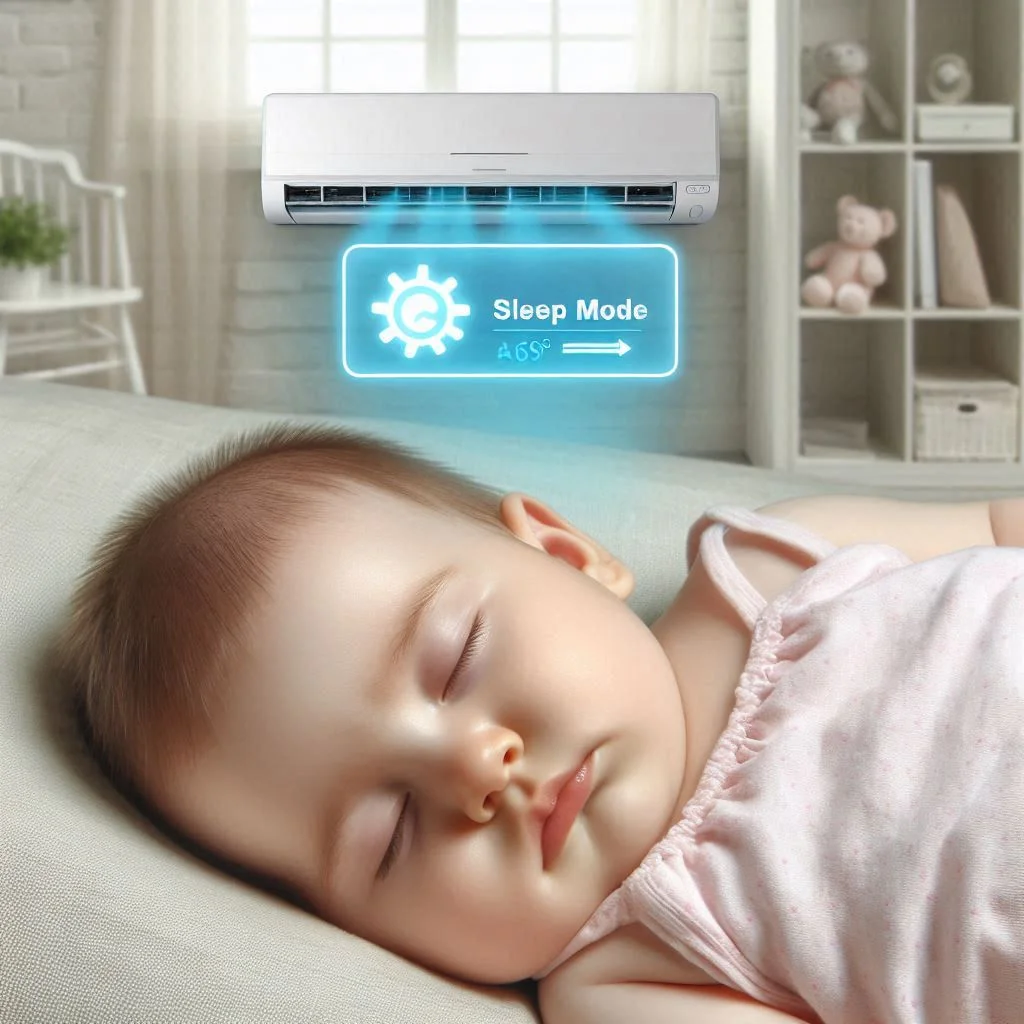
Types of Air Conditioning Units for Nurseries
Choosing the right air conditioning unit for your nursery is crucial to ensuring your baby’s comfort and safety. Different AC types offer unique features, and understanding their benefits and limitations can help you make the best choice for your child’s room.
Window Air Conditioners
Window air conditioners are a popular choice for cooling small spaces like nurseries. These units are installed in a window or wall opening and offer reliable cooling power.
Benefits:
- Compact and space-saving design.
- Affordable and energy-efficient for small rooms.
- Easy to install and maintain.
Considerations:
- May block natural light from the window.
- Limited portability as they are fixed in place.
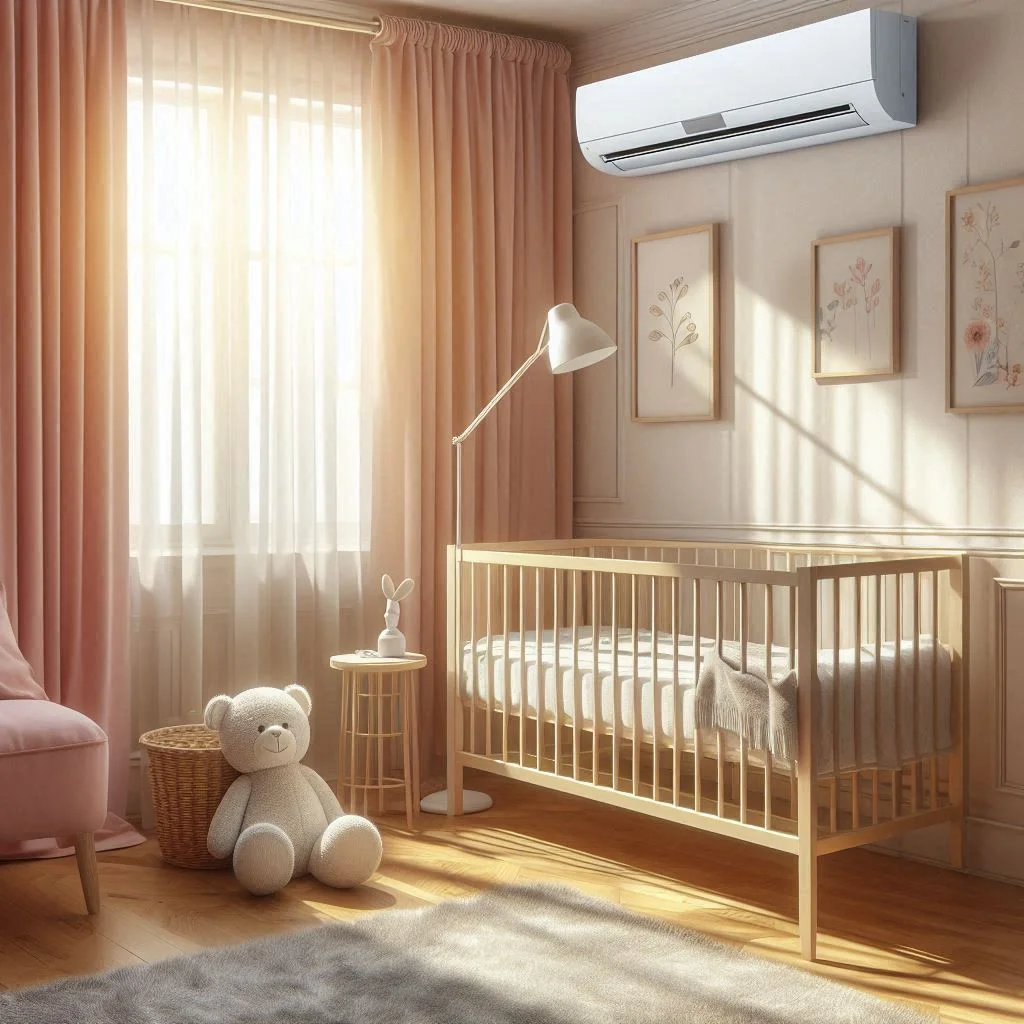
Portable Air Conditioners
Portable air conditioners are standalone units that can be moved from room to room. They are ideal for parents who want flexibility in cooling different parts of their home.
Benefits:
- Mobility allows you to use it in different rooms as needed.
- Quick and easy installation without requiring structural changes.
- Comes with built-in dehumidification in many models.
Considerations:
- Requires venting through a window or door.
- May occupy floor space, making it less suitable for small nurseries.
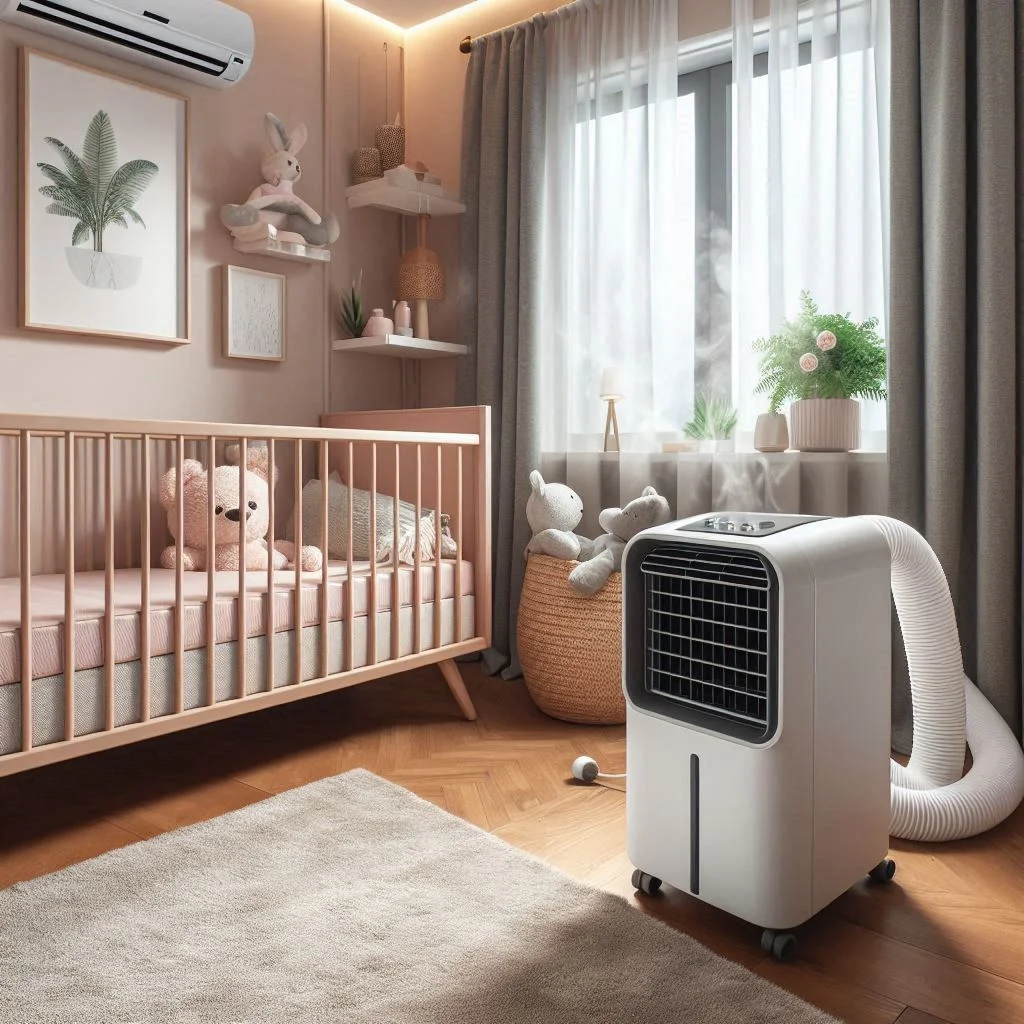
Ductless Mini-Split Systems
Ductless mini-split systems are a versatile and efficient option for nurseries. These units consist of an indoor air-handling unit and an outdoor compressor.
Benefits:
- Highly energy-efficient with precise temperature control.
- Quiet operation, making it perfect for a baby’s room.
- Doesn’t take up window or floor space.
Considerations:
- Higher initial installation cost compared to other options.
- Requires professional installation.
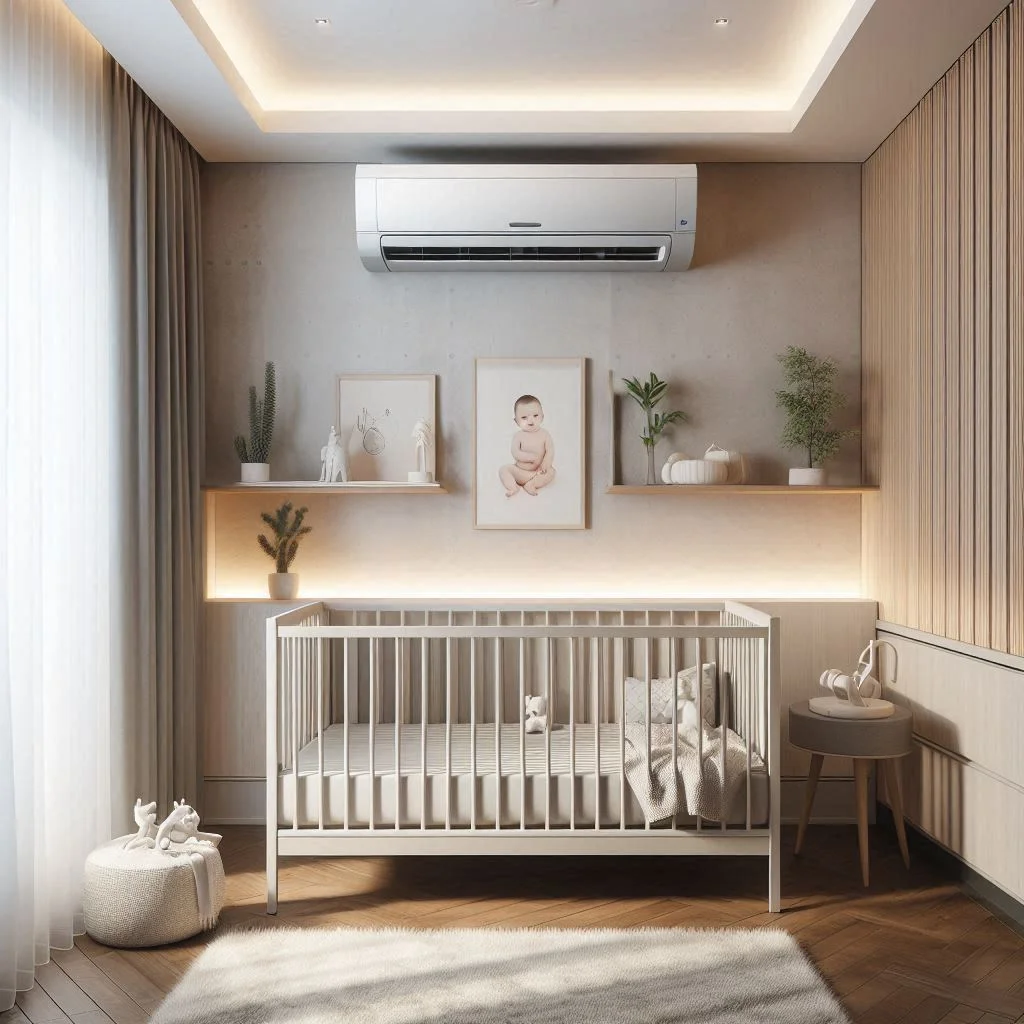
Smart Air Conditioners
Smart air conditioners are the latest innovation, offering advanced features to enhance convenience and control. They connect to Wi-Fi and can be controlled via smartphone apps or voice commands.
Benefits:
- Remote operation ensures you can adjust settings without disturbing your baby.
- Energy-saving modes and scheduling for efficient use.
- Compatible with smart home systems like Alexa or Google Home.
Considerations:
- Higher cost due to advanced features.
- Requires a stable Wi-Fi connection for full functionality.
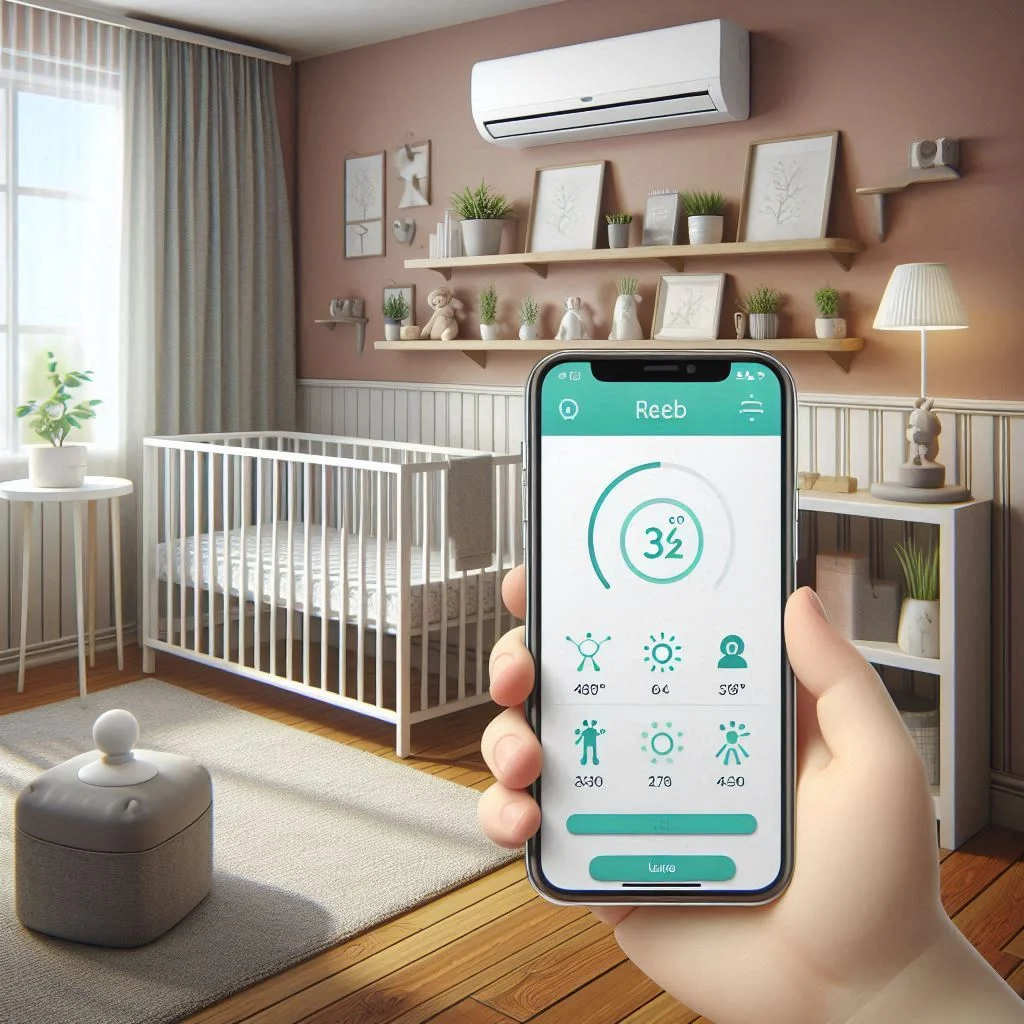
Features to Look for in a Nursery Air Conditioner
When selecting an air conditioner for your baby’s nursery, it’s essential to prioritize features that promote safety, comfort, and energy efficiency. Below are the most important features to consider when investing in a nursery air conditioner.
Temperature Control Options
Maintaining the right temperature is crucial for your baby’s health and comfort. Air conditioners with advanced temperature control options ensure consistent and precise cooling.
Key Features:
- Digital Thermostats: Allow you to set and maintain the ideal temperature, typically between 68°F and 72°F.
- Smart Temperature Control: Models with Wi-Fi compatibility let you monitor and adjust the temperature remotely via a mobile app.
- Auto Mode: Automatically adjusts cooling power based on room temperature, preventing overcooling.
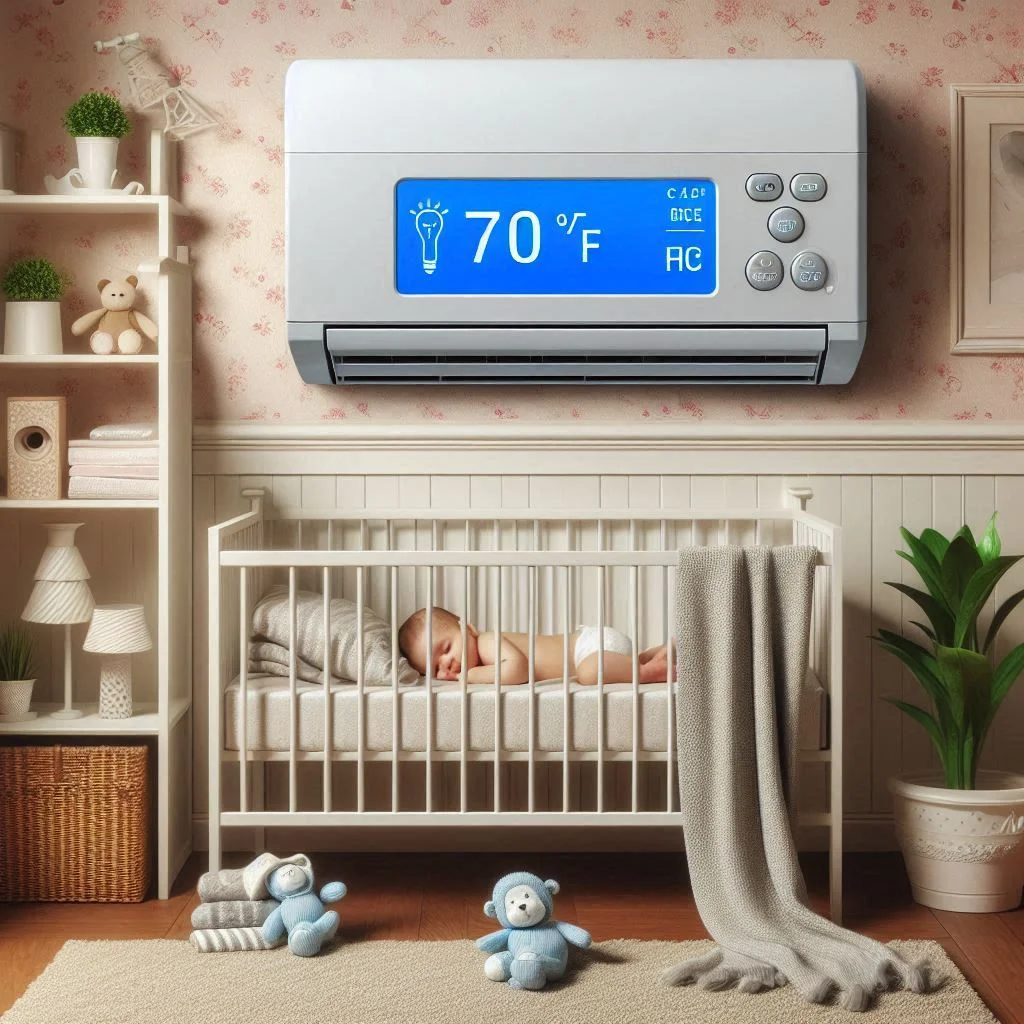
Energy Efficiency and Consumption
Energy-efficient air conditioners save money and reduce your carbon footprint while keeping your baby’s room cool.
Key Features:
- Energy Star Certification: Indicates that the unit meets high-efficiency standards.
- Inverter Technology: Adjusts the compressor speed to maintain the desired temperature, using less energy.
- Energy-Saving Modes: Automatically reduces power consumption when the room reaches the desired cooling level.
Why It Matters:
Lower energy consumption means fewer fluctuations in room temperature and reduced utility costs, providing long-term benefits.
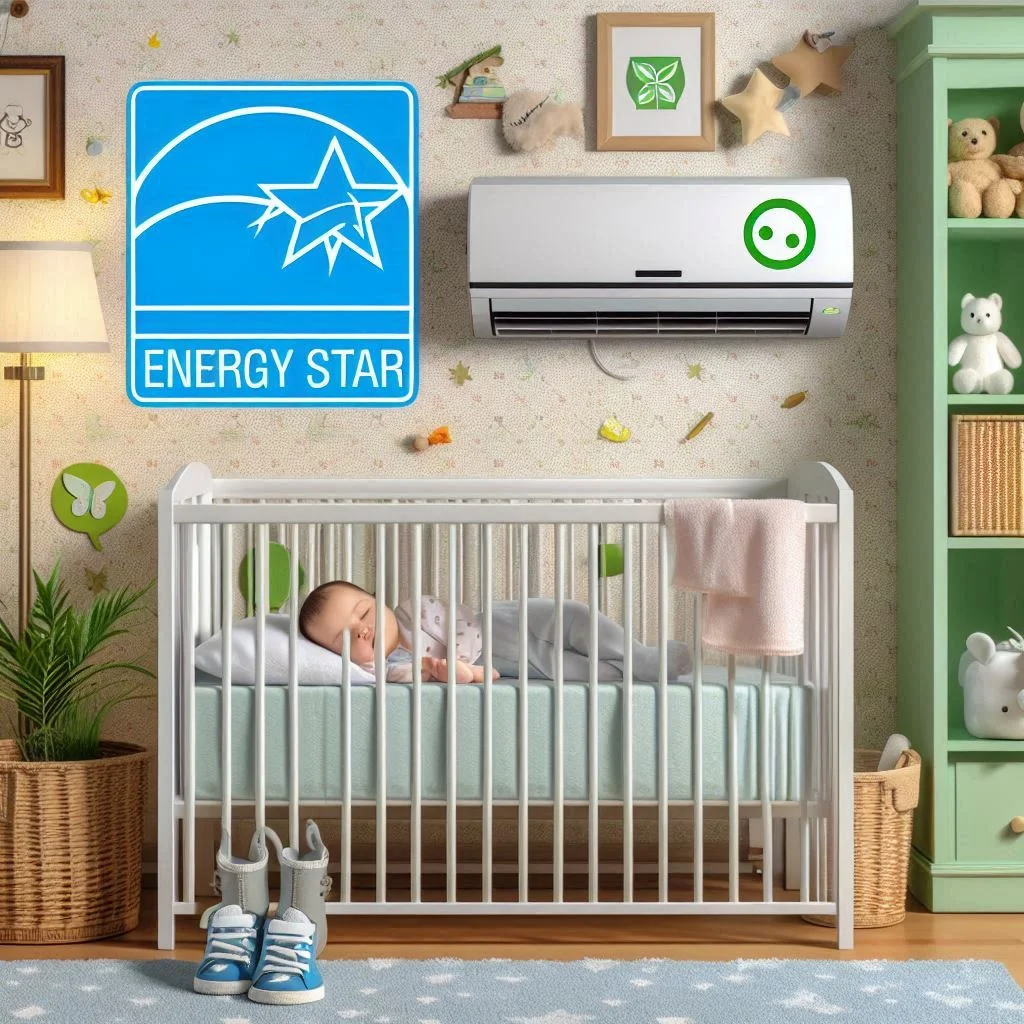
Noise Level Ratings
Babies are sensitive to sound, and a noisy air conditioner can disturb their sleep. Choosing a unit with a low noise level ensures a peaceful environment.
Key Features:
- Quiet Operation: Look for units with a noise rating below 50 decibels (dB), equivalent to a soft conversation.
- Sleep Mode: Reduces noise and dims display lights during nighttime operation.
- Fan Speed Control: Allows for quieter cooling on lower settings.
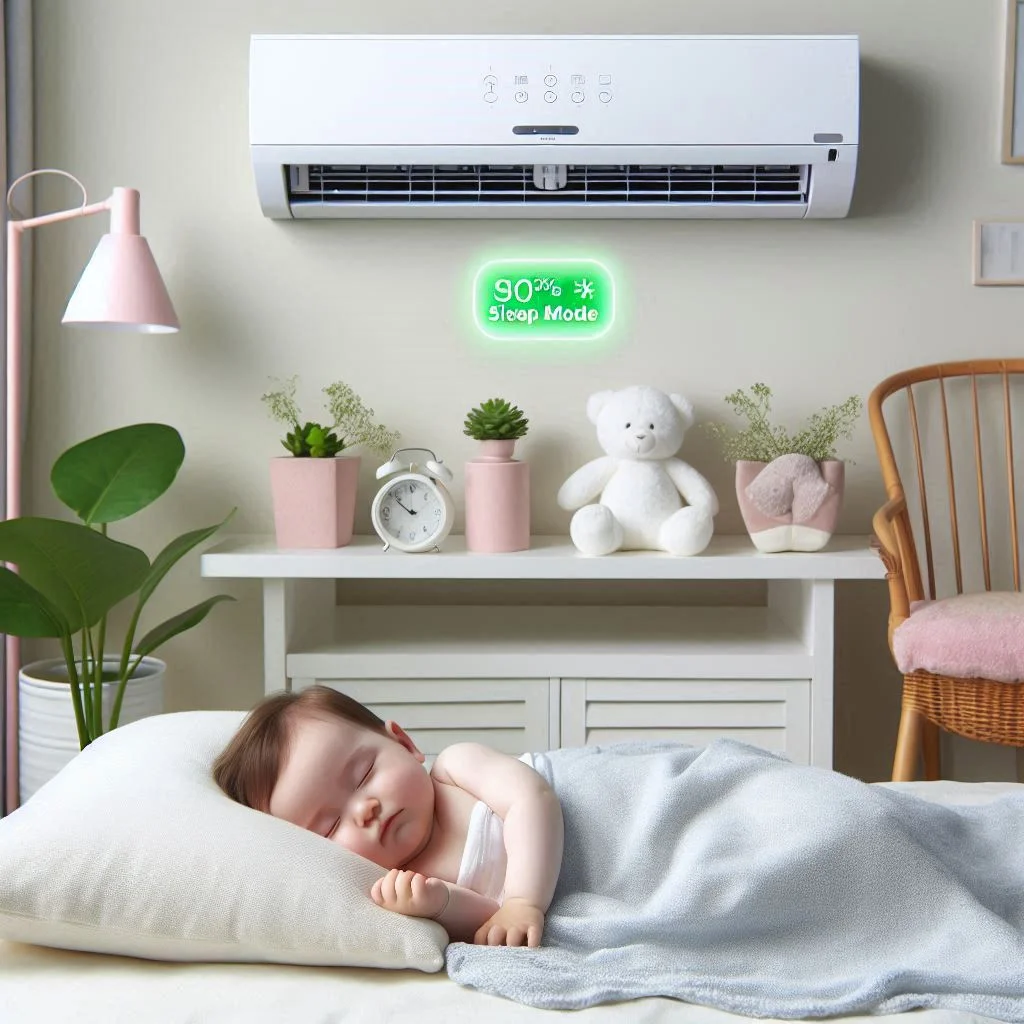
Air Filters for Better Air Quality
Clean air is essential for your baby’s respiratory health. Air conditioners with high-quality filters can improve indoor air quality by removing allergens and pollutants.
Key Features:
- HEPA Filters: Capture fine particles like dust, pollen, and pet dander.
- Activated Carbon Filters: Help eliminate odors and harmful gases.
- UV-C Purification: Kills airborne germs and bacteria, ensuring a healthier environment.
Maintenance Tips:
- Replace filters regularly as per the manufacturer’s recommendations.
- Clean reusable filters every few weeks to maintain efficiency.
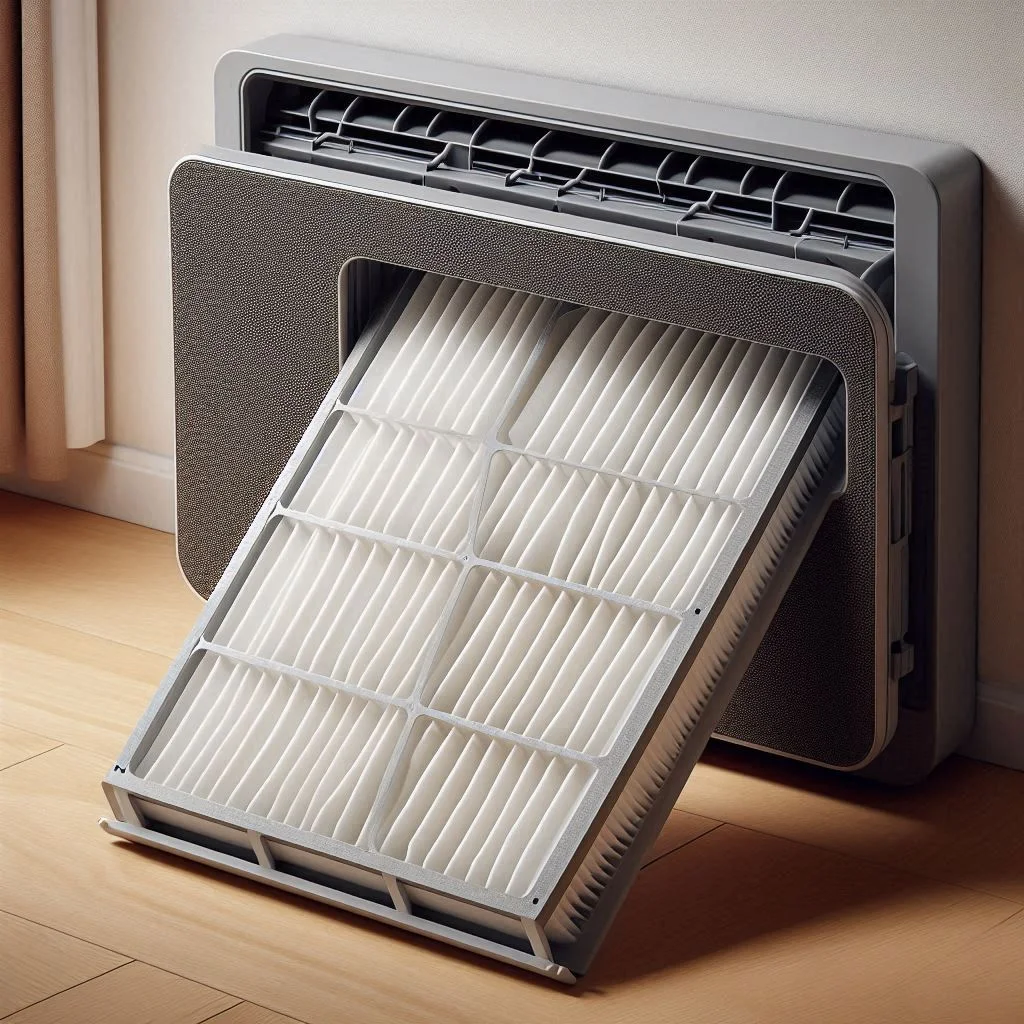
Maintaining Air Quality in the Nursery
Ensuring clean and healthy air in your baby’s nursery is essential for their growth and overall well-being. Poor air quality can lead to respiratory issues and allergies, which are especially harmful to infants. Here’s a detailed look at the key factors in maintaining superior air quality for your nursery.
Importance of Air Filters
Air filters play a pivotal role in trapping airborne particles, ensuring your baby breathes clean air. High-quality filters improve indoor air quality by removing allergens, pollutants, and other harmful substances.
Key Points to Consider:
- HEPA Filters: These filters capture 99.97% of airborne particles as small as 0.3 microns, including dust, pollen, and pet dander.
- Activated Carbon Filters: Help neutralize odors and harmful gases, keeping the nursery fresh.
- Multi-Stage Filtration: Some air conditioners offer multi-stage filtration systems combining HEPA, carbon, and pre-filters for comprehensive air purification.
Maintenance Tip: Replace or clean filters regularly based on the manufacturer’s guidelines to maintain optimal performance.
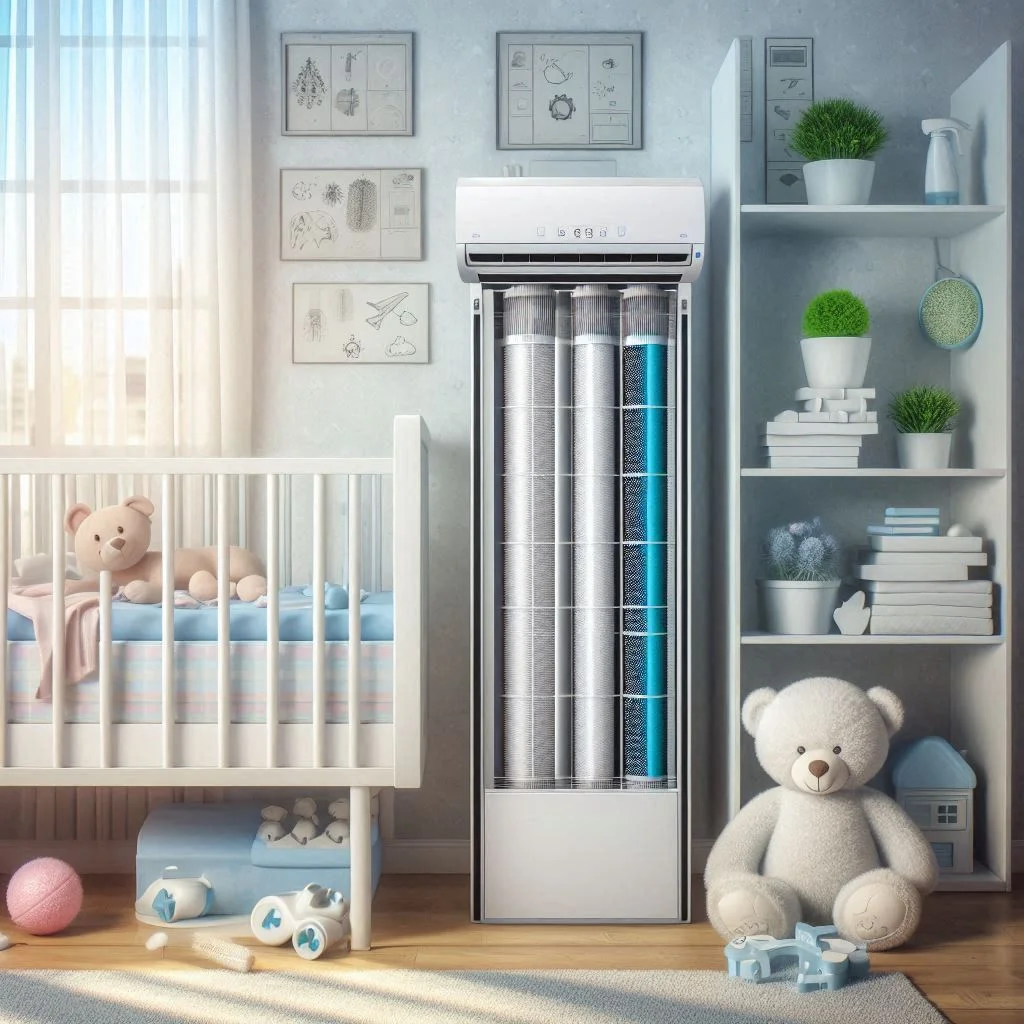
Regular Cleaning and Upkeep
Regular maintenance of your air conditioning system is crucial for maintaining air quality. Dust and debris can accumulate in the unit, reducing efficiency and circulating unclean air.
Steps for Maintenance:
- Clean Air Filters Weekly: Wash or vacuum reusable filters to remove dust buildup.
- Inspect Air Vents: Ensure air vents are free from blockages and dust.
- Schedule Professional Servicing: Have your air conditioning unit professionally cleaned and serviced every 6–12 months.
Benefits:
- Prevents the growth of mold and bacteria in the AC unit.
- Enhances energy efficiency and prolongs the lifespan of the system.
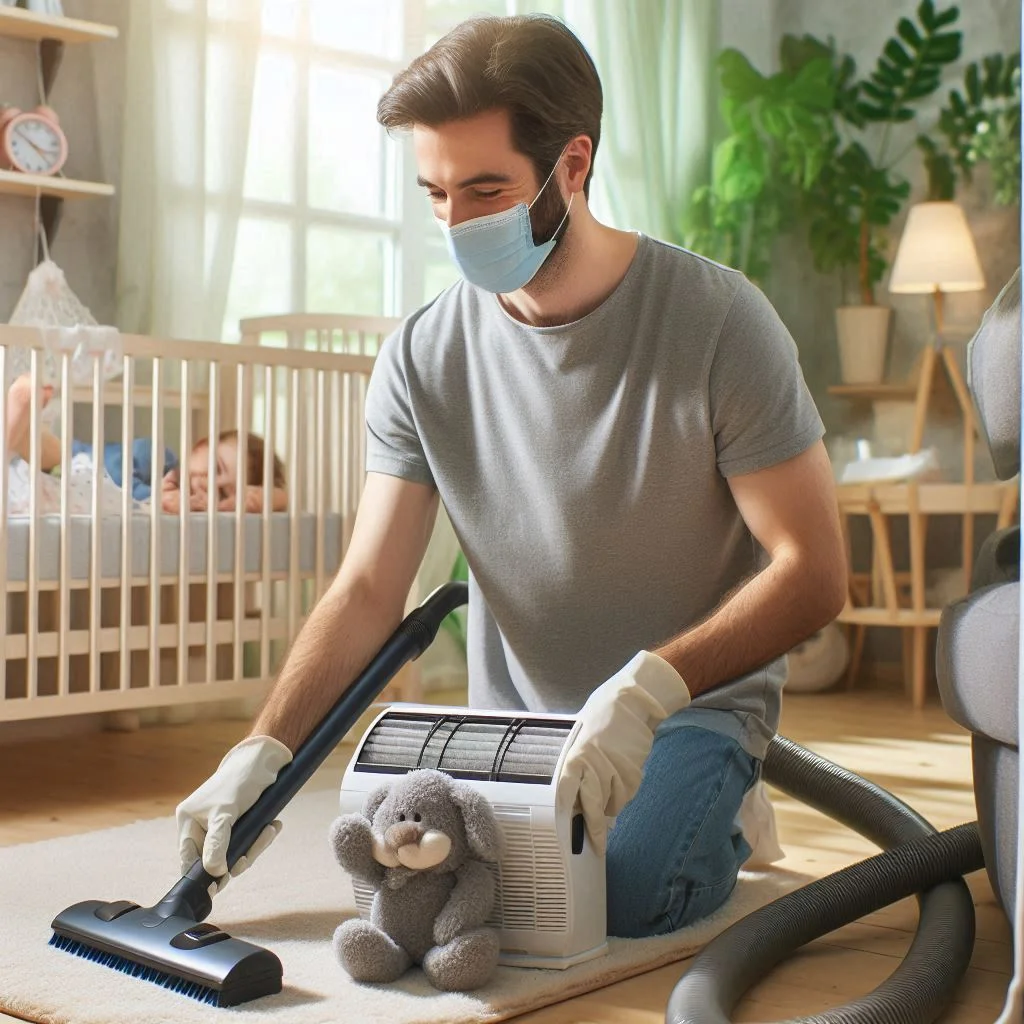
Using UV-C and Advanced Monitoring Systems
Innovative technologies like UV-C systems and air quality monitors are game-changers for nursery air conditioning. These advancements offer additional protection against harmful microbes and ensure you stay informed about air quality.
UV-C Systems:
- Use ultraviolet light to kill bacteria, viruses, and mold inside the AC unit.
- Prevents the recirculation of harmful microorganisms in the nursery.
Advanced Air Quality Monitoring Systems:
- Real-time monitoring of air quality levels, including humidity, temperature, and pollutant levels.
- Alerts parents when adjustments or maintenance are needed to optimize air quality.
Benefits:
- Ensures a safer environment for babies, particularly those with allergies or asthma.
- Provides peace of mind by automating air quality checks.
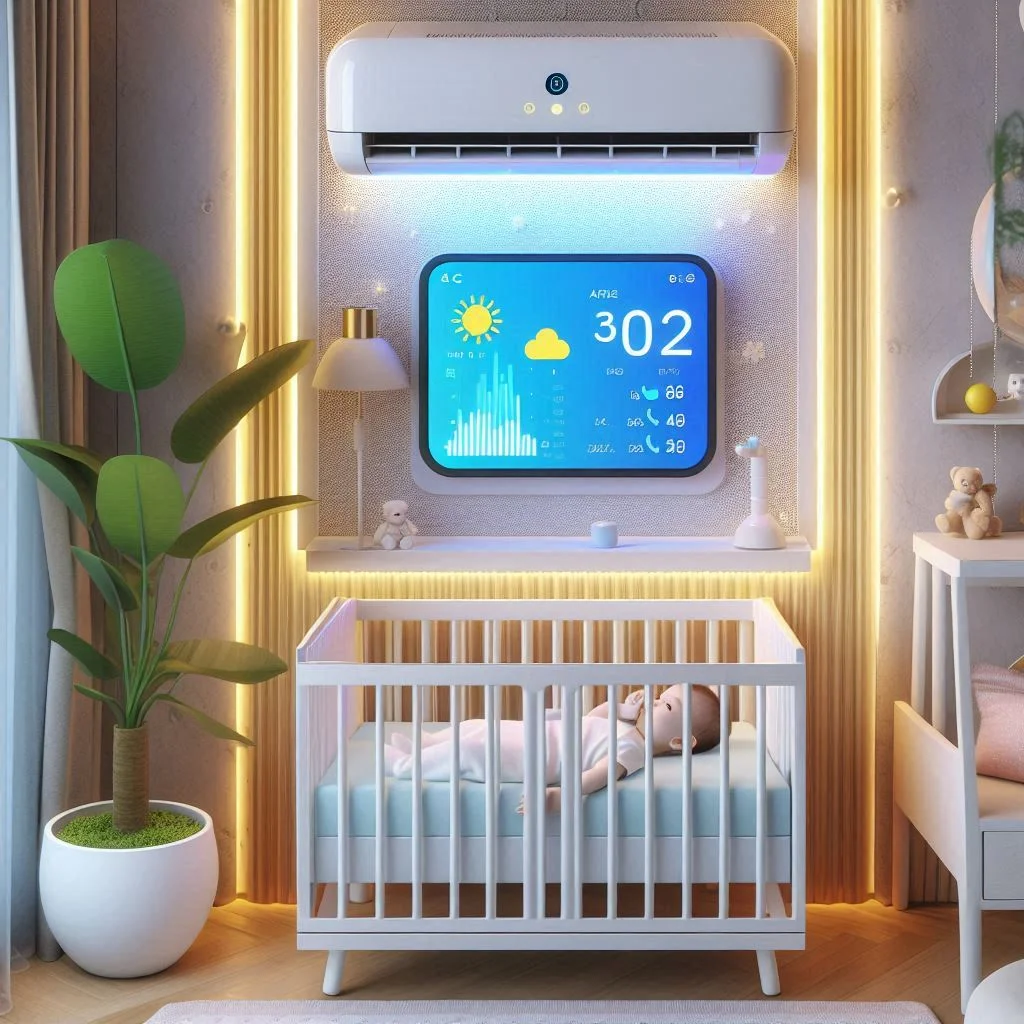
Best Air Conditioners for Nurseries
Selecting the best air conditioner for your nursery ensures a safe and comfortable environment for your baby. Below are some of the top options that prioritize energy efficiency, quiet operation, and air quality.
hOmeLabs Window Air Conditioner
The hOmeLabs Window Air Conditioner is a reliable and affordable choice for small spaces like nurseries. It is designed to deliver efficient cooling without compromising on energy savings.
Key Features:
- Compact Size: Perfect for small rooms, saving space while maintaining effective cooling.
- Energy Star Certified: Consumes less electricity while providing optimal performance.
- Multiple Modes: Includes cooling, fan-only, and eco modes to suit various needs.
- Quiet Operation: Operates at a noise level of around 50 dB, ensuring minimal disturbance to your baby’s sleep.
Why It’s Ideal for Nurseries:
- The energy efficiency and quiet operation make it an excellent choice for maintaining a consistent temperature without excessive power usage.
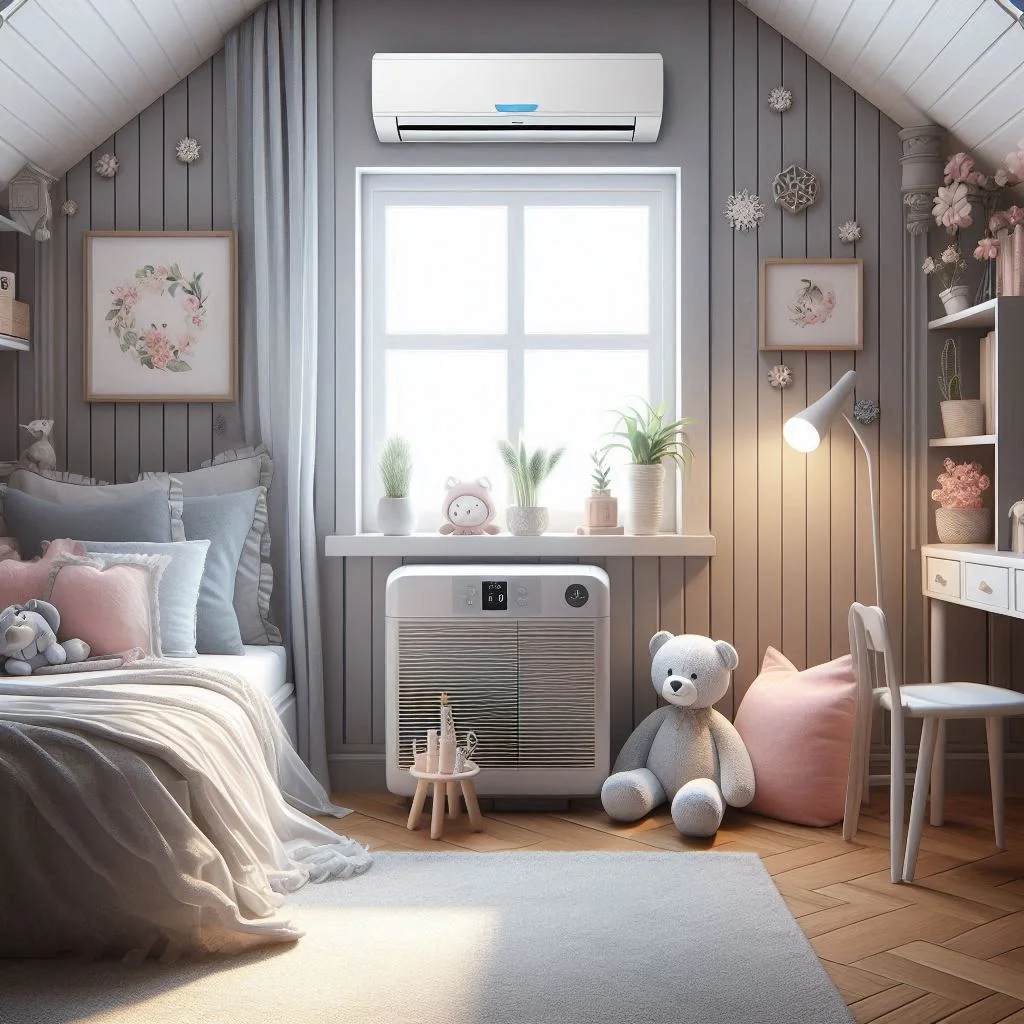
Evapolar Portable Air Cooler
The Evapolar Portable Air Cooler is an innovative, eco-friendly solution for localized cooling in nurseries. This compact unit uses evaporative cooling technology, making it ideal for parents looking for a safe and energy-efficient alternative.
Key Features:
- Compact and Portable: Lightweight design allows for easy repositioning around the nursery.
- Evaporative Cooling Technology: Uses water to cool air naturally, maintaining optimal humidity levels.
- Air Purification: Built-in filters remove dust and allergens from the air.
- Energy Efficient: Consumes significantly less energy compared to traditional AC units.
Why It’s Ideal for Nurseries:
- The natural cooling method and air purification features make it perfect for maintaining a healthy and comfortable environment for infants.
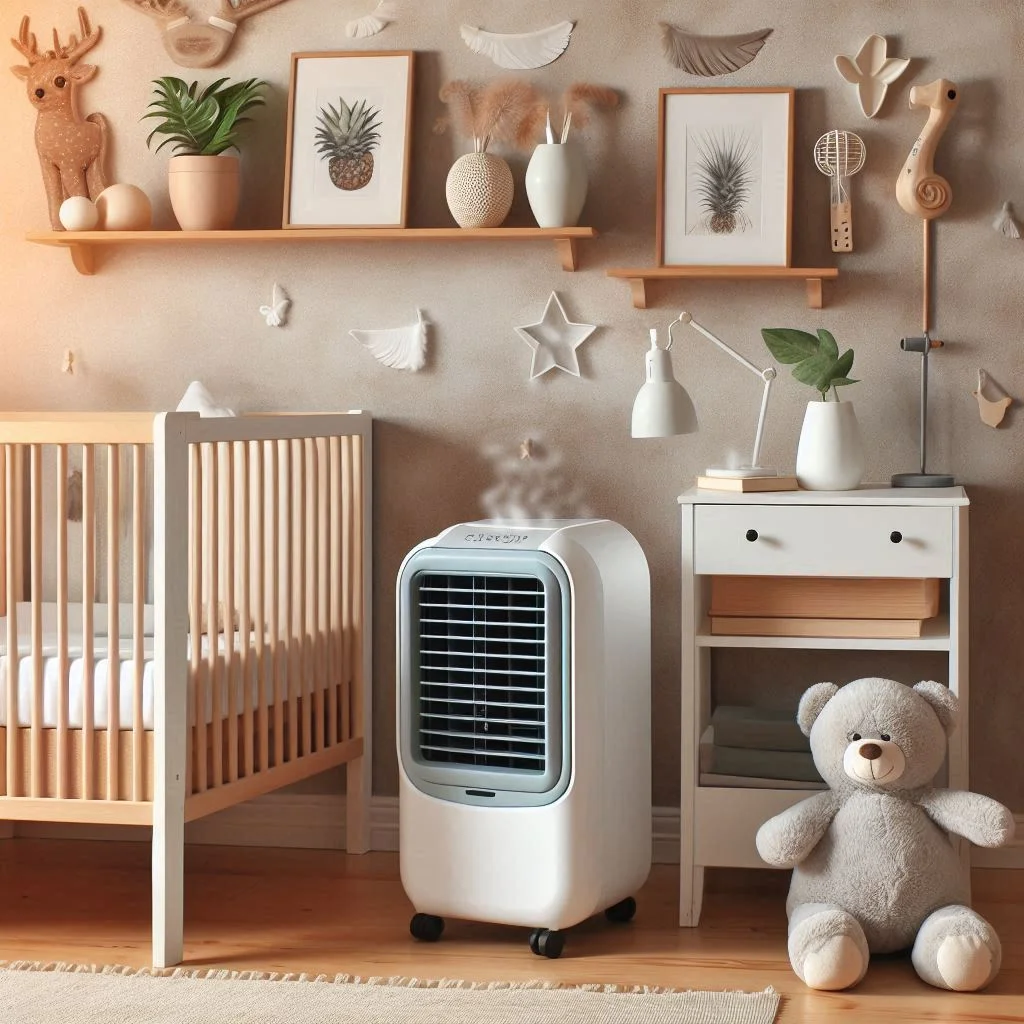
Geothermal AC Units for Consistent Cooling
Geothermal AC units are an advanced solution for families seeking long-term energy-efficient cooling. These systems utilize the earth’s natural temperature to provide consistent and eco-friendly air conditioning.
Key Features:
- Energy Efficiency: Geothermal units are highly efficient, reducing electricity bills significantly.
- Consistent Temperature: Maintains a steady indoor climate, ideal for nurseries where temperature fluctuations can be disruptive.
- Environmentally Friendly: Produces minimal greenhouse gas emissions compared to traditional air conditioners.
- Quiet Operation: Operates silently, ensuring undisturbed sleep for your baby.
Why It’s Ideal for Nurseries:
- The reliability and efficiency of geothermal systems make them a premium choice for creating a stable, safe, and sustainable cooling environment.
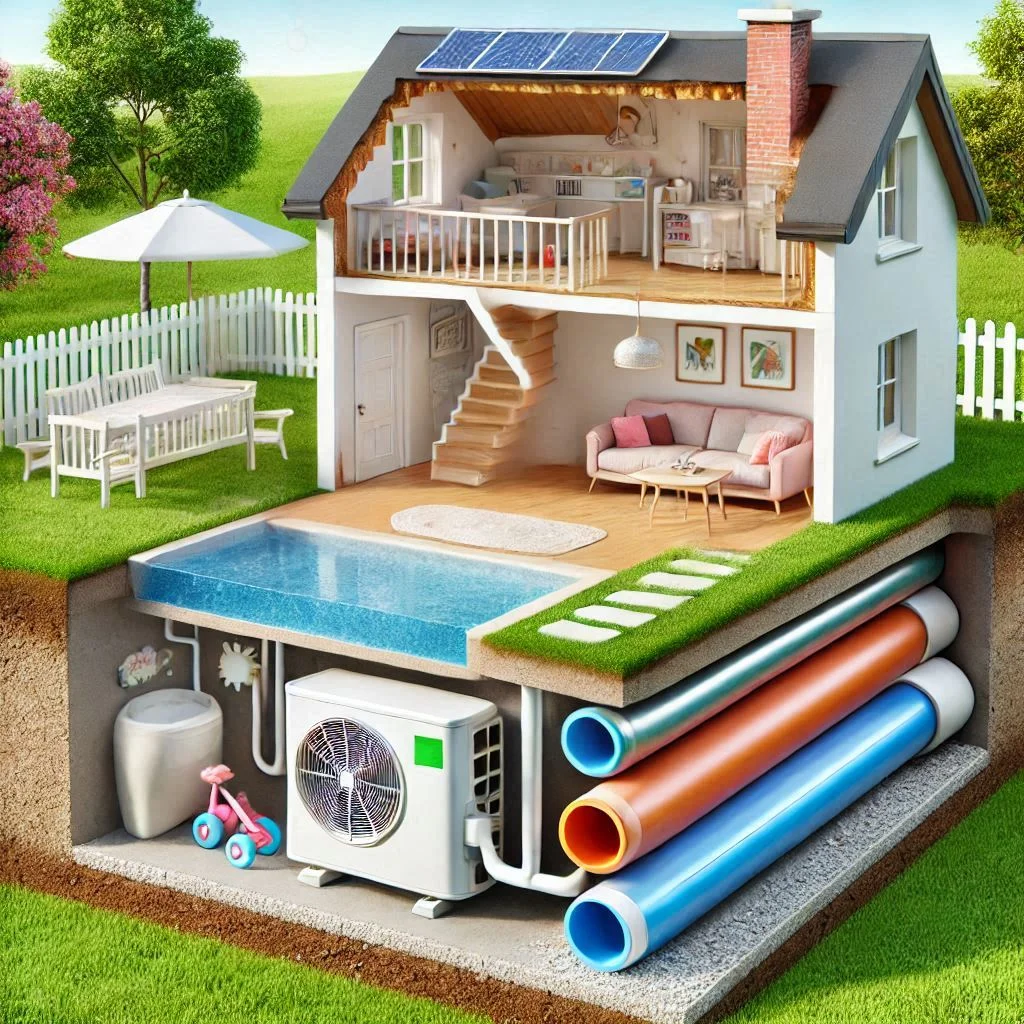
Safety and Innovation in Nursery Air Conditioning
Creating a safe and advanced cooling environment in your nursery is crucial for your baby’s well-being. Modern air conditioning systems offer features that prioritize safety, convenience, and health. This section highlights the importance of childproofing, smart monitoring, and UV-C systems for maintaining a secure and germ-free space.
Childproofing Your Air Conditioner
Childproofing is essential to prevent accidents and ensure your baby’s safety around air conditioning units. Here are practical steps to secure your AC system:
Steps to Childproof Your AC Unit:
- Use Protective Covers: Install vent covers and shields to prevent tiny fingers from accessing moving parts or sharp edges.
- Secure Electrical Outlets: Use outlet covers or safety plugs for the AC’s power source to avoid electrical hazards.
- Position the Unit Wisely: Place portable or wall-mounted units out of your child’s reach or behind furniture.
- Install a Lock Feature: Many modern air conditioners have child-lock settings to prevent tampering with the controls.
- Cord Management: Keep cords and wires hidden or secured using cable organizers to eliminate tripping or strangulation risks.
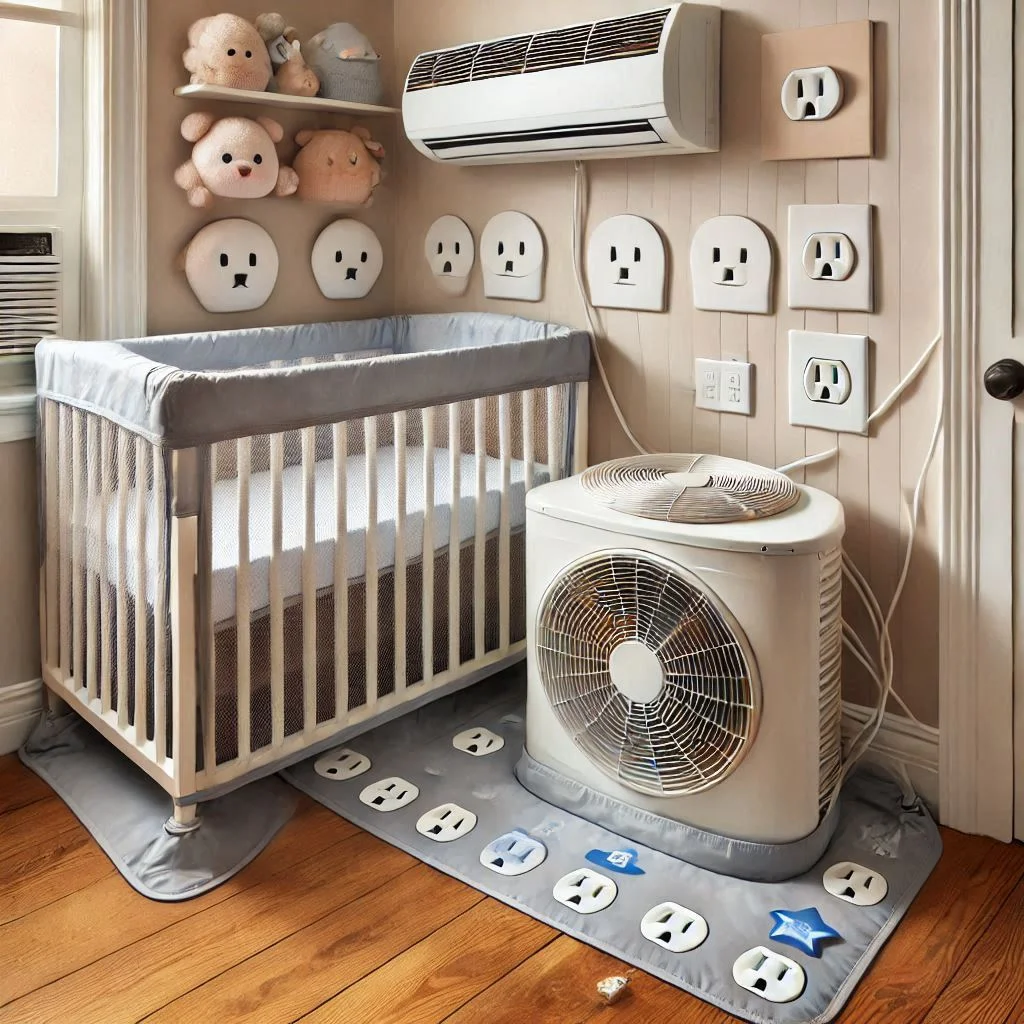
Smart Features for Remote Monitoring
Modern air conditioners come equipped with smart technology, enabling remote control and monitoring through smartphones or voice-activated systems.
Key Smart Features:
- Temperature Monitoring: Adjust the room’s temperature remotely to maintain optimal comfort for your baby.
- Activity Notifications: Receive alerts if the unit is tampered with or if the temperature deviates from the set range.
- Energy Usage Tracking: Monitor energy consumption to reduce costs and maintain eco-friendly operation.
- Voice Control Integration: Compatible with devices like Alexa or Google Assistant, allowing for hands-free adjustments.
Benefits for Nurseries:
- Provides convenience for busy parents.
- Ensures precise temperature control at all times.
- Enhances overall safety by monitoring activity remotely.
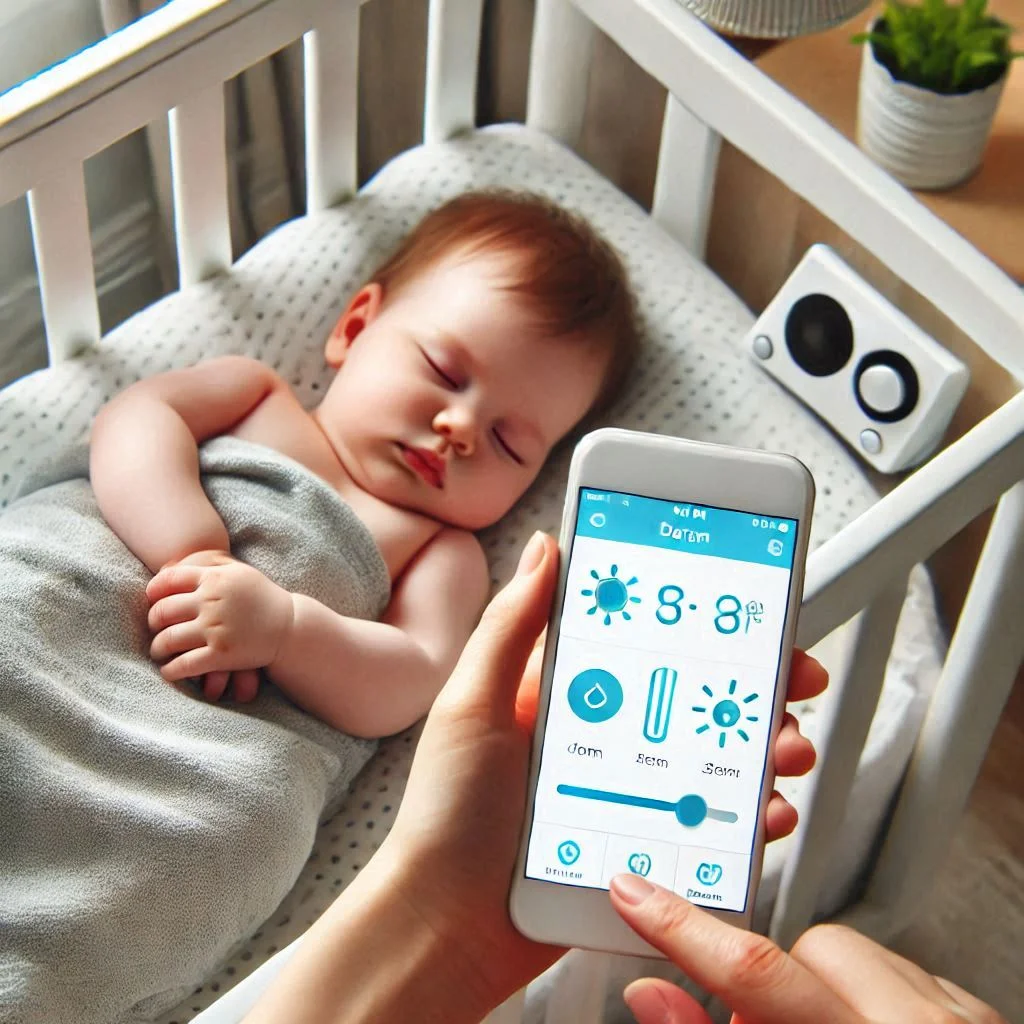
UV-C Systems for Germ-Free Air
UV-C systems in air conditioners provide an additional layer of safety by eliminating harmful microorganisms, ensuring a cleaner and healthier environment for your baby.
How UV-C Systems Work:
- Ultraviolet Germicidal Irradiation (UVGI): UV-C light targets and destroys bacteria, viruses, and mold in the air conditioning unit.
- Continuous Air Disinfection: The system works silently in the background, constantly sterilizing circulating air.
Advantages in a Nursery Setting:
- Protects against respiratory issues caused by airborne pathogens.
- Prevents mold buildup within the AC system, ensuring a cleaner output of air.
- Requires minimal maintenance, offering a cost-effective solution for long-term health benefits.
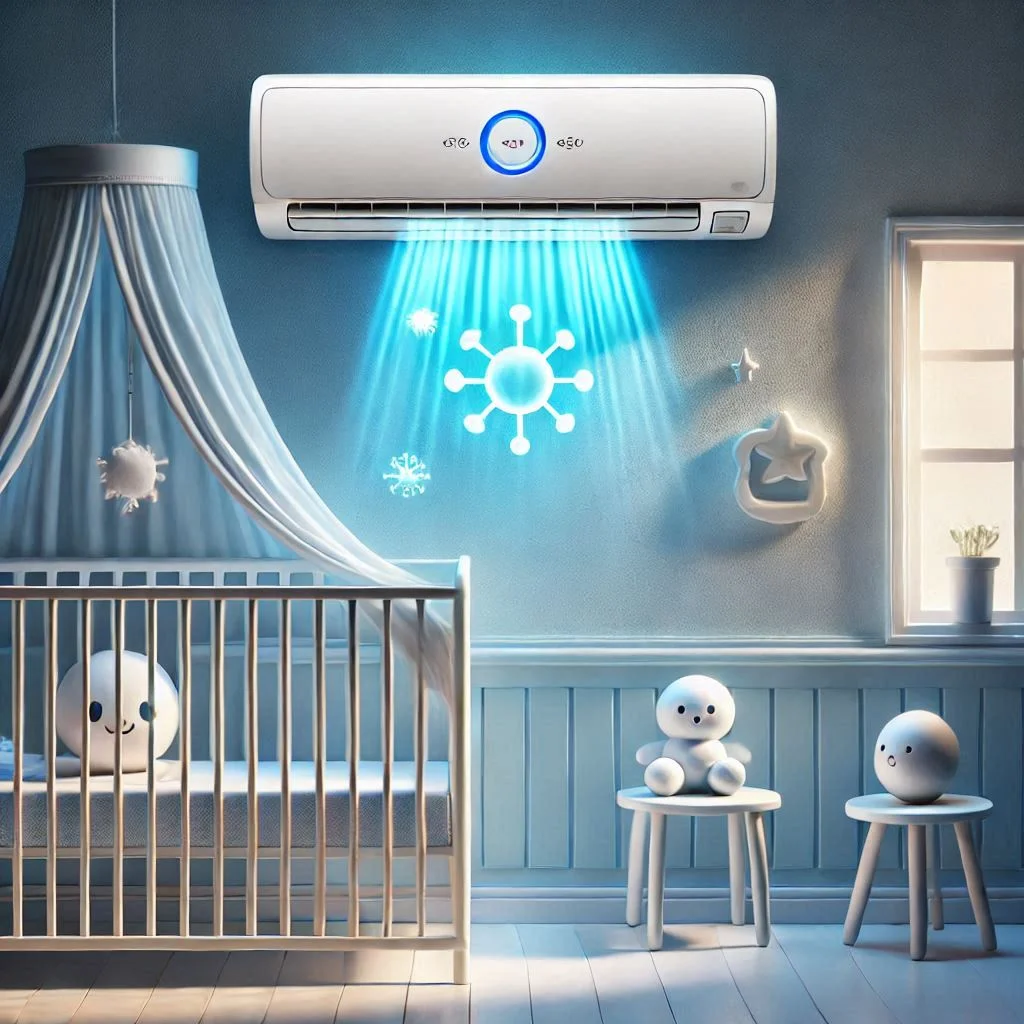
FAQs About Nursery Air Conditioners
Parents often have concerns and questions about using air conditioning in nurseries. Below, we address common queries to help ensure a safe, comfortable, and healthy environment for your baby.
Are air conditioning units safe for babies?
Yes, air conditioning units are safe for babies when used appropriately. Proper installation and temperature settings are crucial to avoid any adverse effects.
Key Safety Considerations:
- Temperature Control: Keep the room temperature between 68°F and 72°F, which is ideal for infants.
- Regular Maintenance: Ensure the unit is clean and functioning efficiently to prevent dust or allergen buildup.
- Moderate Usage: Avoid overcooling the room, which can lead to discomfort or respiratory issues.
- Humidity Levels: Maintain a humidity level of 40%-60% to prevent dry air.
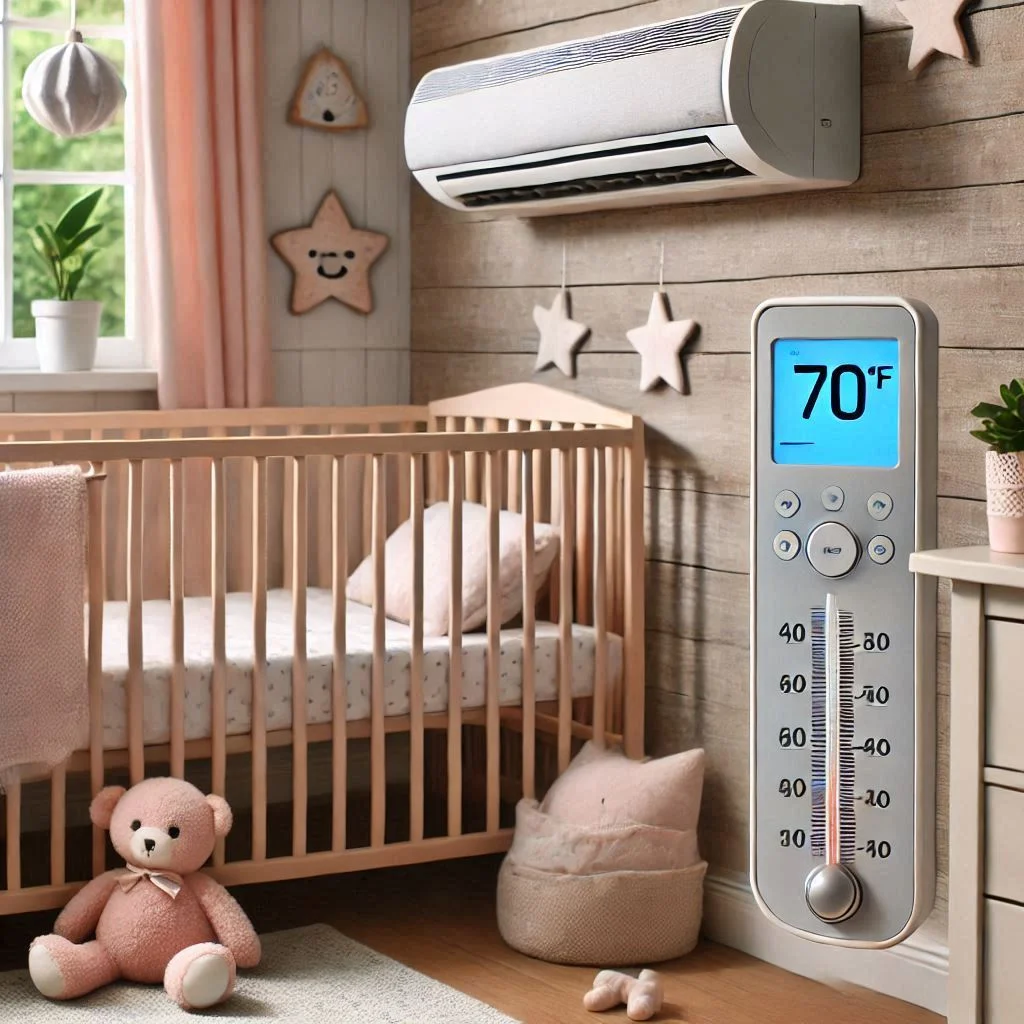
How can I childproof an air conditioner?
Childproofing an air conditioner ensures your baby stays safe from potential hazards.
Steps to Childproof Your AC Unit:
- Install Vent Covers: Prevent access to sharp fins or moving parts.
- Hide Cords and Wires: Use cord organizers to keep cables out of reach.
- Wall-Mounted Units: Place air conditioners at a height inaccessible to children.
- Child Lock Features: Many modern units come with built-in child locks to prevent tampering with settings.
- Cover Electrical Outlets: Use outlet covers to protect the power source.
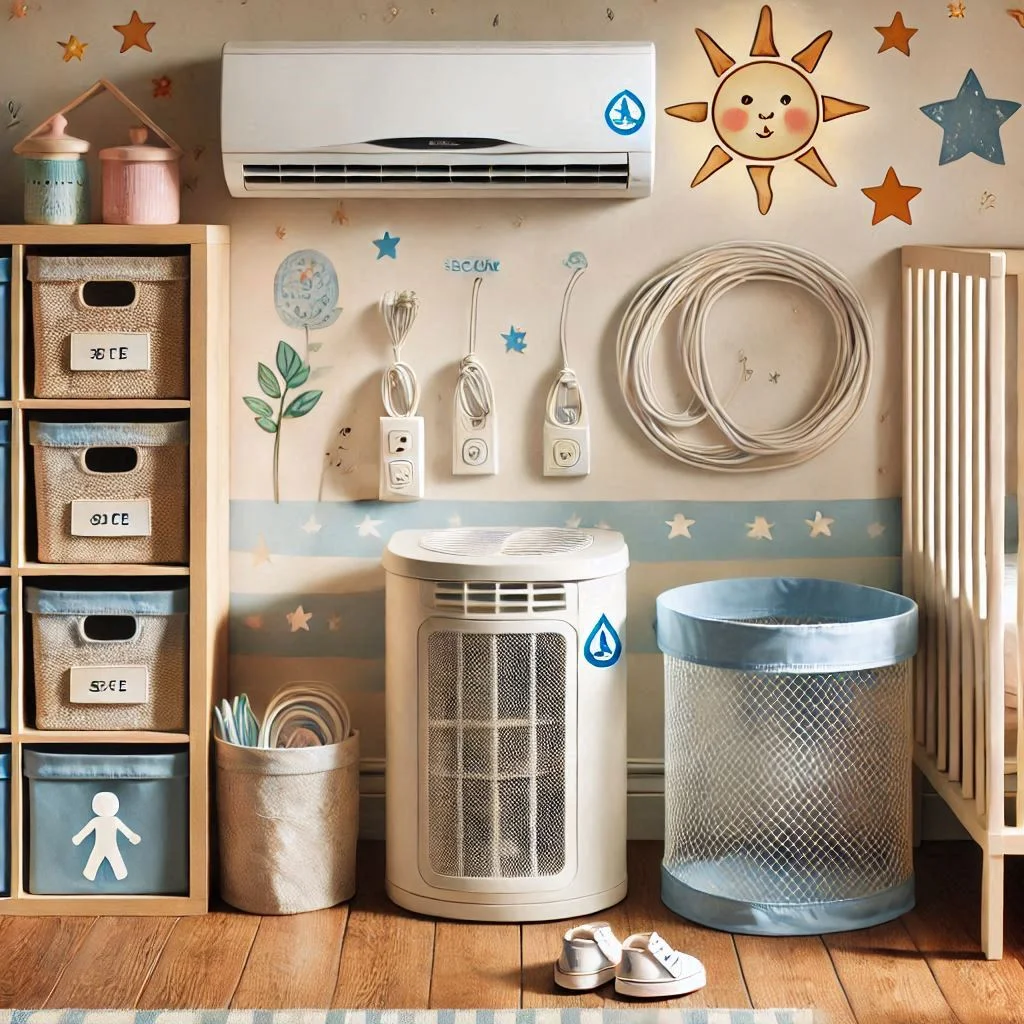
What is the ideal temperature for a nursery?
The recommended temperature range for a nursery is 68°F to 72°F. This range ensures comfort and prevents risks like overheating or excessive cooling.
Why It Matters:
- Thermal Regulation: Infants cannot regulate their body temperature effectively, making a consistent environment critical.
- Sleep Quality: A comfortable temperature promotes better sleep and reduces the likelihood of waking due to discomfort.
- Health Considerations: Avoids overheating, which can increase the risk of Sudden Infant Death Syndrome (SIDS).
Tips for Maintaining Temperature:
- Use a programmable thermostat to monitor and adjust temperatures.
- Pair the AC unit with blackout curtains or insulated windows to prevent heat gain.
Can air conditioning affect a baby’s health?
Air conditioning can positively or negatively impact a baby’s health depending on its usage.
Positive Effects:
- Allergen Control: Filters in AC units reduce airborne allergens, improving air quality.
- Comfortable Environment: Helps avoid heat-related illnesses like dehydration or heatstroke.
Potential Risks:
- Dry Air: Prolonged use may reduce humidity levels, leading to dry skin or nasal passages.
- Temperature Fluctuations: Overcooling or frequent changes in temperature can cause colds or discomfort.
Solution:
- Use humidifiers to maintain optimal humidity.
- Regularly clean air filters to ensure healthy airflow.
Do portable ACs require venting in nurseries?
Yes, most portable air conditioners require venting to expel hot air effectively.
How It Works:
- Portable AC units come with an exhaust hose that needs to be connected to a window or vent.
- Proper venting ensures the system cools efficiently and prevents heat buildup.
Alternatives for Nurseries Without Venting Options:
- Evaporative Coolers: These units do not require venting and are suitable for smaller spaces.
- Ductless Systems: A more permanent and efficient solution for cooling without large hoses or windows.
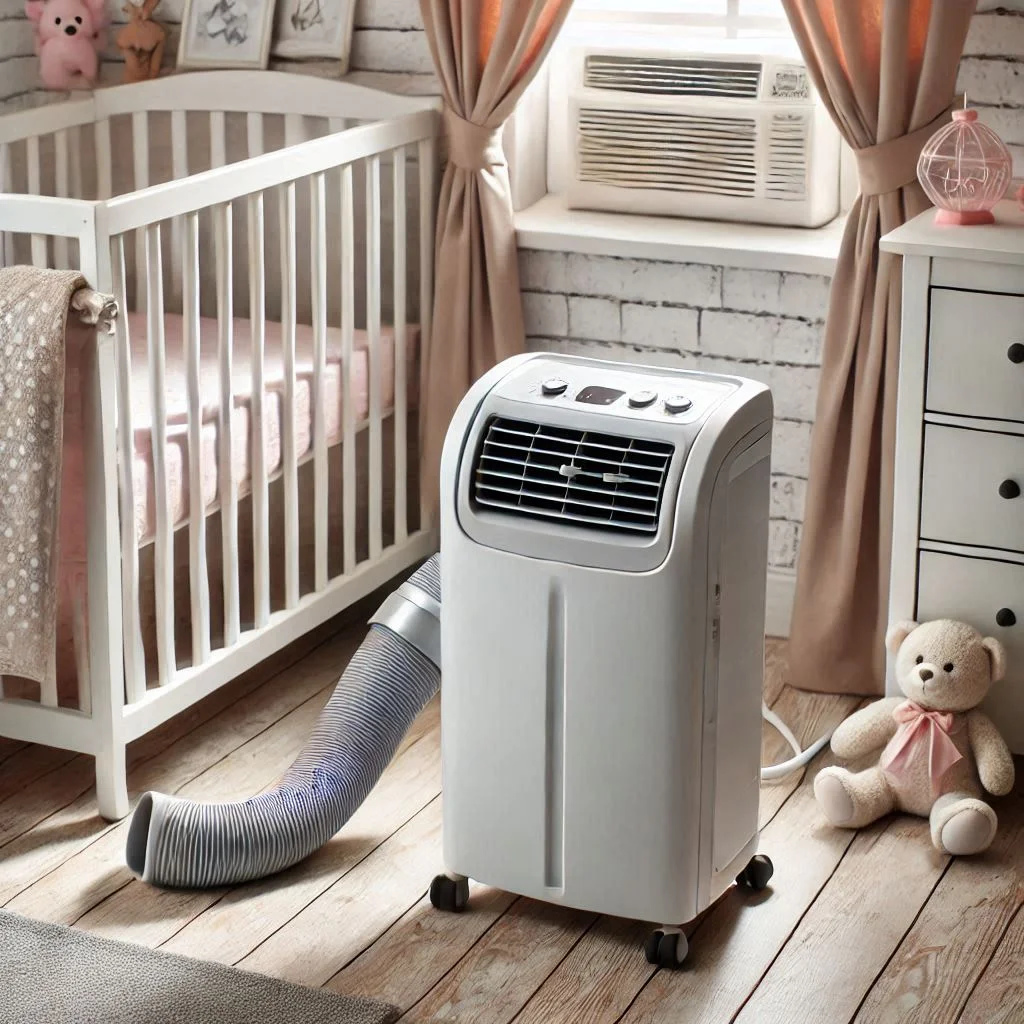
Conclusion
Creating a safe, comfortable, and healthy environment for your baby is a top priority, and choosing the right air conditioner for your nursery plays a significant role in achieving this. From understanding your nursery’s cooling needs to selecting the best unit type and exploring innovative safety features, every decision can impact your baby’s comfort and well-being. Prioritizing features like temperature control, energy efficiency, and air quality ensures that your nursery remains a nurturing space, free from health risks and discomfort.
By combining smart technologies, regular maintenance, and childproofing measures, you can transform your baby’s room into a haven of relaxation and safety. With this comprehensive guide, you’re equipped to make informed choices that balance functionality, safety, and innovation, providing your little one with the ideal start in a cozy and secure environment.

